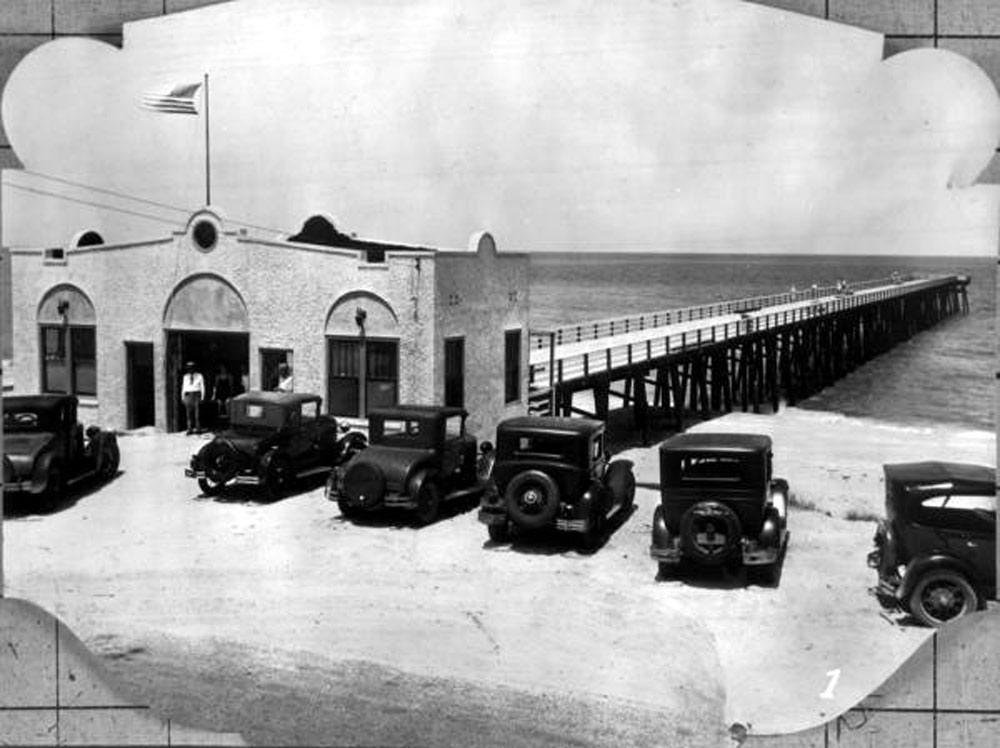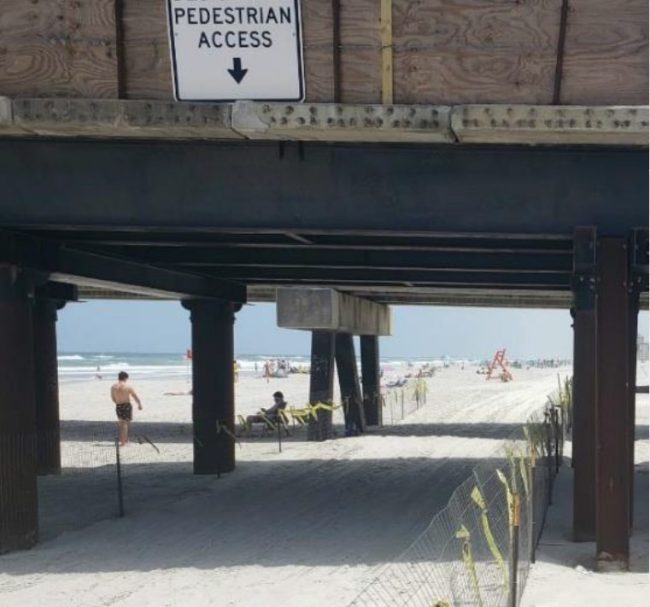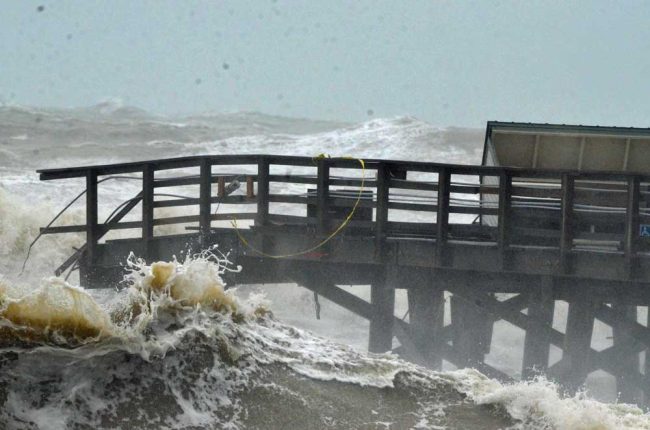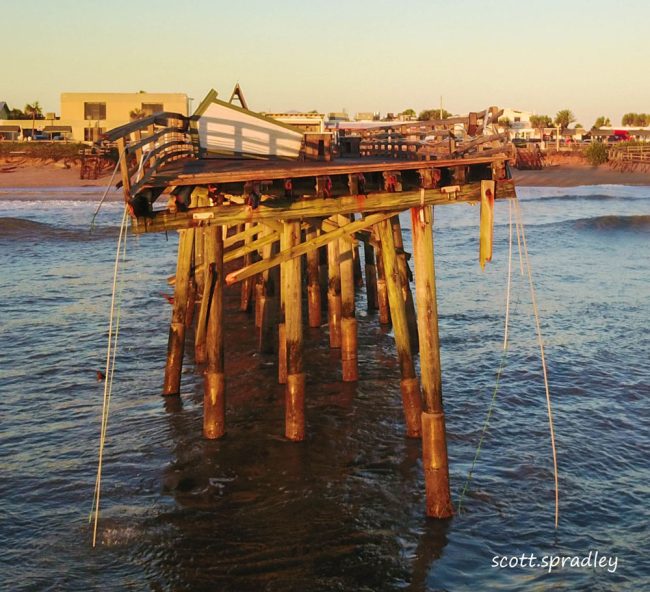
After a relatively brief, 15-minute discussion that belies nearly nine years of anguish, delays, debates, financing and design of a new pier, the Flagler Beach City Commission Thursday evening unanimously approved a $14.1 million contract with Beckley, W.Va.-based Vecellio and Grogan to build a 714-ft. concrete pier in place of the existing, 97-year-old wooden relic, which has been closed to public or any use since the fall of 2022. About 113 feet of the existing pier’s structure connecting it to land will be preserved, for a total length of just under 829 feet.
Don’t fret: its earliest version in the 1920s was 200 feet shorter.
But the project’s timeline has continued to be significantly pushed back, as it was again on Thursday. Two years ago, when the design firm unveiled the first major overview of the project, construction was to start in the spring of 2024 and be completed by the end of 2025. Last summer, the city administration issued a timeline that projected bid openings in August, the contract award in September or October, and the start of construction in December, with substantial completion by February 2026 and the pier reopening by April 2026.
All those dates have gone overboard, as of course had a previous goal of completing the pier in time for the city’s centennial, which is this year: Flagler Beach was founded on April 16, 1925. As the schedule now stands, the contractor may well begin construction on the centennial.
Gabe Perdomo, project manager with Moffatt and Nichol, the Long Beach, Calif.-based firm the city hired in 2022 to design the pier and oversee the project, told the City Commission Thursday that construction may not start until March, April or even May, and may not be completed by July 4, 2026, the new target date. The city is eager to have the pier completed by then, if only to end the city’s July 4 fireworks drought, which by then will have lasted six years. The city’s request for proposals was issued Nov. 29 and responses opened Jan. 15. Vecellio and Grogan’s was the lone submission.
“There’s a lot of variables potentially between here and there, with the weather, etc.,” Perdomo said. “It may be that July 4 might be a little too ambitious at this point, because it might be one, two or three months down. But we understand, the contractor understands how important that July 4 target is, and he’s going to do everything he can in order to try to meet that.”
“I would assume that starting one or two or three months late simply adds one or two or three months to the to the project completion,” Commission Chair Scott Spradley said.
Parking will be restricted from third to fifth street on the east side of A1A during construction, on the south side. (See the map here.) “That being said, the intent is for there to be no other disruptions,” Perdomo said. “In terms of lane closures, we might have to do a little bit of restriping, shift the lanes a little bit so that there’s enough room for travel lanes in both directions along that portion of A1A. So although the parking will be impacted, we do not expect that there are going to be any road closures because of the construction of the pier.”

No other changes are expected on A1A or State Road 100. No impacts are expected on traffic and parking (aside from the restrictions over three blocks) or on the new Margaritaville Hotel, which opens later this year. As for impacts on visitors, Spradley said, “I guess everyone would say yes, that’s going to happen. But the city is not unaware of that, and I’m sure that as we approach that, efforts will be made by city manager, by public safety to take care of the visitor situation.”
“I don’t know if it’s really accurate to say it’s going to have a big impact on visitors or tourism,” City Commissioner Eric Cooley said, “because there’s one delineated area the contractor has to work, that they won’t be able to go to. Other than that, we’ve got seven miles.” The contractor will also ensure that there is a safe crossing point beneath the pier, so beach-goers can walk from north to south, what Perdomo described as safety zones, such as the delineated passageway beneath the construction zone.
For surfers and swimmers, “we do not have any areas that are in the water that are restricted outside of the city’s safety area,” Perdomo said. “There will have to be some collaboration between the contractor and code enforcement, or law enforcement.”
The new pier will be 25 feet wide, or 5 feet wider than its timber ancestor. As with the old pier, the new version will include a 32-foot-wide, 20-foot-long T-head at its eastern end. , while the old pier was 20 feet wide. There’ll be fish-cleaning stations, shade canopies and benches.
Among their documentation, commissioners were provided a page that lists the line-by-line cost estimates of each major part of pier construction by the design firm, alongside the line-by-line actual cost listed by the contractor. The overall cost is close: the design firm estimated a cost of $14.4 million. Vecellio and Grogan is putting the actual cost at $14.14 million.

There were differences with the design firm’s estimates. For example, the contractor listed mobilization costs significantly higher than the design firm estimated: $1.43 million versus $234,000. (Mobilization is the cost of securing and assembling all needed equipment before construction begins.) The designer estimated a cost of $4.3 million for the trestle–the skeletal metal frame the contractor will build around the existing pier in order to demolish it. The contractor’s cost is only $2.7 million, because the contractor already owns a trestle, making it unnecessary to buy steel, or for the city to buy that equipment. The trestle will obviously be assembled at the pier.
The demolition, including removal of underwater debris, pier spans, timber pilings and deck planks will cost $387,000. New concrete piles will cost $1.175 million, and total cost for construction of the new pier structure itself will be $5.6 million (the designers had estimated $7.5 million). The pier will rest on 24-inch square concrete piles. Its concrete and wood deck will be markedly higher than the existing pier–from 17.8 feet now to 28 feet–to account for rising sea levels and rougher seas. (See: “Flagler Beach’s New Concrete Pier Will Be 10 Feet Higher to Account for Sea Rise and Violent Storms.”)
But commissioners were surprised by the lighting cost the contractor is listing: $630,000. So were the designers. “There’s not much lighting on the pier. We have to adhere to the FWC turtle lighting requirements,” Perdomo said of the Florida Fish and Wildlife Conservation Commission’s rules on limiting lighting at the shore so as not to disorient sea turtles. “We were a little bit surprised by that.” But for the $14 million cost overall, Perdomo said, the cost is “absolutely” justified.

“If you want to see their work, Jax pier is what to look at,” Cooley said, referring to the 1,285-foot-long Jacksonville pier at 503 1st Street, which reopened after being closed for six years. It, too, was rebuilt at a higher elevation. I’ve been up there numerous times, and they’ve got a good looking pier,” Commissioner Eric Cooley. But when Jacksonville announced its repair plans, the city projected an 18-month timeline and completion by May 2021. It took 14 months longer.
The Federal Emergency Management Agency (FEMA) is assuming 75 percent of the cost of construction. Half the remaining 25 percent will be paid through the Florida Department of Emergency Management and half from the Department of Environmental Protection, sparing both Flagler Beach and Flagler County from having to spend a dime: the state grants were secured when Paul Renner, who represented Flagler County at the Legislature, was speaker of the House, a position he leveraged to the county’s benefit.
The federal and state payments will come in as reimbursements. So the city has secured a revolving loan of $21 million. “The City will pay the invoice through short-term loan funds, then the City will seek reimbursement from FEMA/FDEM/FDEP, and then re-pay the short-term loans funds (and interest) on a recurring cycle through the project,” a memo to the commission by City Manager Dale Martin states.
The city will also be moving ahead with the construction of its new “Promenade,” the revamped boardwalk, south of the pier–possibly by Vecellio and Grogan, and concurrently with pier construction. “That could buy us some couple of months, two, three months of mobilization,” Perdomo said, “but we expect that the construction duration of the promenade would be somewhere on the order of about four to six months, with pre-construction activities, mobilization, demobilization. And so the promenade would be completed towards the latter part of 2026,” or just after the current projection of the pier’s completion date. As always, storms and hurricanes may have other ideas.
Vecellio and Grogan was founded in the thick Beckley’s Appalachian mountains in 1938 as a highway contractor and in coal-mining construction (Beckley used to be a hub of the coal mining industry, but no longer), soon expanding to mid-Atlantic states, then to bridge-building and pier-building. The company has been registered in Florida since 1995. In the last five years the company completed the $10 million reconstruction of the Jacksonville Beach Pier (as Hal Jones Contractor, a subsidiary), the $11 million Ft. Pierce Marina, a $27 million interchange on I-26 in North Carolina, and the $3.1 million St. Augustine Marina.
![]()




























Doug says
Not that I am for taxing unnecessarily, but why aren’t the Flagler Beach residents accessed a special tax for the rebuilding of the pier? The pier has always been the focal point of Flagler Beach that’s enjoyed by some residents, and most tourists, yet they are not taxed for the costs of construction? Yet, Flagler County wants to impose the residents of the barrier island a tax to re-nourish the beaches for 99% of the tourists to enjoy. Where is the fairness Flagler County? What is good for one, should be good for the other.
Larry says
If FEMA goes away, will FEMA’s expected 75% portion of pier funding go away too?
Doug says
I don’t believe FEMA will go away, but hopefully we’ll see more accountability. Too many Chiefs and not enough Indians.